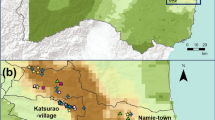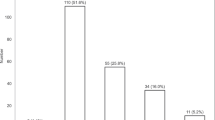Abstract
In the present chapter, I present the distribution of radiocesium in wild boars as well as the official monitoring data of wild boars from Fukushima. After the nuclear accident in 2011, the radiocesium contamination levels in wild boars from most places in Fukushima Prefecture exceeded 100 Bq/kg. The most contaminated wild boars were observed in Soso district where the radiocesium concentration in the soil was the highest in the entire Fukushima Prefecture. To understand radiocesium contamination in wild boars in more detail, we measured radiocesium concentrations in different organs and tissues of wild boars inhabiting Iitate Village in Soso district in 2012 and 2013. After capturing the wild boars, we collected 24 organs and tissues and put them into vials. Using an NaI(Tl) scintillation counter, we determined the concentrations of radiocesium (134Cs and 137Cs) and found that the levels were highest in the muscles (approximately 15,000 Bq/kg) and lowest in the ovaries (approximately 600 Bq/kg) in 2012, indicating a large variation between the organs and tissues. The trends were similar in 2012 and 2013. Observations of the contamination levels in wild boars could reveal the radiocesium availability in the forest and village ecosystem.
You have full access to this open access chapter, Download chapter PDF
Similar content being viewed by others
Keywords
- Fukushima Daiichi nuclear power plant accident
- Wild boar
- Radiocesium
- Fission products
- Food security
- Wild animals
- Wild life
- Forest
- Radioactive contamination
9.1 Introduction
Significant quantities of radiocesium were released during the accident at the Fukushima Dai-ichi Nuclear Power Plant (FDNPP) of the Tokyo Electric Power Company in March 2011 (Yasunari et al. 2011; Zheng et al. 2014). From soil measurements, it was shown that radiocesium was highly deposited in the north-western region of the power plant (Saito et al. 2015). Fortunately, very small quantities of radiostrontium (Steinhauser et al. 2013) and plutonium (Zheng et al. 2012; Schneider et al. 2013) were deposited in the soil in most areas of Fukushima. Several months after the accident, the dominant radionuclides in the soil were 134Cs and 137Cs. There have been many kinds of inspections of agricultural products and foods in Fukushima Prefecture, and the contamination levels in the wild animals of the forests, particularly wild boars, were found to be very high, presumably because wild boars have a habit of eating soil attached to their food, similar to an earthworm. Firstly, I summarized the inspection data of wild boars from Fukushima prefecture in the next section.
Data for radiocesium distribution in animals were limited. Green et al. (1961) reported the distribution of radiocesium and potassium in pigs and calves. Fukuda et al. (2013) reported radiocesium distribution in cattle. These reports showed that radiocesium levels were the highest in muscles and that there were large variations between the organs. Here, I present the radiocesium distribution within wild boars captured in Iitate Village where the habitants remain evacuated because of the high radiation levels caused by radiocesium deposition (Fig. 9.1).
9.2 Inspection Data from Fukushima
The inspection data is accessible from the website “Fukushima Shinhatsubai” (http://www.new-fukushima.jp/monitoring/en/). I have summarized the data and separated it according to each district (Fig. 9.2). The radiocesium levels were high in Soso district, and the highest concentration of 137Cs exceeded 50,000 Bq/kg in 2013. Because the radiocesium levels remained high during these 4 years, we cannot speculate about when the meat of wild boars from this area can be used as food. From April 2012, the standard in Japan for the allowable radiocesium concentration in meat has been 100 Bq/kg (Hamada et al. 2012). The current radiocesium levels in wild boar meat are now significantly higher than the standard level.
9.3 Distribution of Radiocesium in Wild Boars in 2012 and 2013
Because Iitate Village is now in the evacuation zone, damage to agricultural fields by wild animals such as monkeys and wild boars has been increasing. Before the nuclear power plant accident, hunting was performed to control the number of wild animals, and some of the hunted animals such as wild boars and deer were sold for meat. However, the radiocesium contamination in wild animals now prevents people from hunting them. The wild animal problem has become more serious with time.
In 2012, members of the NPO “Resurrection of Fukushima” and researchers from the University of Tokyo started to investigate the radiocesium levels in wild boars in Iitate Village (Tanoi et al. 2016). Wild boars were hunted for pest control and then the organs, tissues, contents of digestive organs, and blood were collected (Figs. 9.3 and 9.4). We investigated seven wild boars in 2012 and two wild boars in 2013. Five were captured in a single cage on November 25, 2012 (identified as 20121125-01 to 20121125-05) and two on November 29, 2012 (20121129-01 and 20121129-02). Two more boars were captured in separate cages on December 6, 2013 (20131206-01 and 20131206-02). Radiocesium in the samples were measured using a NaI(Tl) scintillation counter (2480 WIZARD2 gamma counter, PerkinElmer, Waltham, MA). Only the radiocesium activities of the blood samples taken in 2012 were measured using a germanium semiconductor detector (GEM-type, ORTEC, SEIKO EG&G, Tokyo, Japan).
Wild animals hunted as vermin were consumed previously as game meat. In Japan, the radiocesium concentration in food has been controlled according to the sum of 134Cs and 134Cs activities (Bq kg−1). In general, we eat the muscles of wild animals. The average radiocesium concentration in muscle tissues was approximately 15,000 Bq kg−1, which was the highest value among the organs tested (Fig. 9.5). In addition to the muscle, most of the organs exceeded the provisional regulation value for meat (500 Bq kg−1) (Hamada et al. 2012), which was the regulation level of radiocesium until March 31, 2012, although the new standard from April 1, 2012 remains at 100 Bq kg−1 (Hamada et al. 2012). The radiocesium concentrations in the ovaries were the lowest among the organs (600 Bq kg−1); however, they still exceeded the provisional regulation value (Fig. 9.5). None of the organs were distributed as food.
The 137Cs accumulation patterns were almost the same between 2012 and 2013. The highest 137Cs concentrations were found in the muscles, kidneys, tongue, and heart (Figs. 9.5 and 9.6). The tissues with low 137Cs were similar between 2012 and 2013. The lowest 137Cs concentrations were found in the ovaries, bone, and thyroid glands. The trend is similar to that observed in cattle contaminated by the FDNPP accident in 2011 (Fukuda et al. 2013), whereby the radiocesium concentrations in the muscle, kidney, tongue, and heart were consistently higher than the other organs. In addition to cattle, the radiocesium concentrations were highest in the muscles of pigs fed with brown rice that was contaminated by the FDNPP accident, followed by the liver and digestive tract, which follow a similar ranking to our data (Ohmori et al. 2014). In addition, when pigs were contaminated by the global fallout around 1950–1960, the ranking of contaminated organs was similar to the present study: higher concentrations in the muscle, kidney, and heart and lower concentrations in the brain, blood, and female reproductive tract (ovary and uterus in our study) (Green et al. 1961).
Wild boars eat a variety of foods such as plants, insects, mushrooms, and small animals; therefore, the radiocesium concentration in the stomach contents reflect the available radiocesium in the forest ecosystem. In the present study, the 137Cs concentrations of boar stomach contents in 2012 and 2013 were almost the same (Figs. 9.5 and 9.6), indicating that the 137Cs situation in the forest did not change between 2012 and 2013. However, the 137Cs concentrations in organs and tissues were different between 2012 and 2013 (Figs. 9.5 and 9.6). It is unclear why stomach contents did not correlate with the organs in terms of 137Cs. Furthermore, the reason for different 137Cs concentrations between juveniles and adults in 2013 is unclear. We need to continue monitoring the wild boars to understand the reasons for these results.
Collecting blood is much easier than collecting other organs or tissues. Thus, it is of interest to compare the 137Cs concentrations in blood with those in other organs or tissues. The 137Cs concentration ratios of blood to muscles are summarized in Table 9.1. Unfortunately, the 137Cs ratio of blood to muscle was not consistent, indicating that blood is not a suitable material for monitoring radiocesium concentrations in the muscle of wild boars. We also found species differences, whereby the ratios of 137Cs concentration of blood to muscles in wild boar, 0.24 on average, were much higher than the value of 0.04 reported for cattle (Fukuda et al. 2013), 0.01 for calf (Green et al. 1961), and 0.10 for pig (Green et al. 1961). The reason why these 137Cs concentration ratios differed so markedly among animals remains unclear.
References
Fukuda T, Kino Y, Abe Y et al (2013) Distribution of artificial radionuclides in abandoned cattle in the evacuation zone of the Fukushima Daiichi nuclear power plant. PLoS ONE 8:e54312. doi:10.1371/journal.pone.0054312
Green RM, McNeill KG, Robinson GA (1961) The distribution of potassium and caesium-137 in the calf and the pig. Can J Biochem Physiol 39:1021–1026. doi:10.1139/o61-102
Hamada N, Ogino H, Fujimichi Y (2012) Safety regulations of food and water implemented in the first year following the Fukushima nuclear accident. J Radiat Res 53:641–671. doi:10.1093/jrr/rrs032
Ohmori H, Sasaki Y, Tajima K, Katsumata M (2014) Radioactive caesium concentrations in pigs fed brown rice contaminated by the Tokyo Electric Power Company Fukushima Daiichi nuclear power plant. Livest Sci 159:156–160. doi:10.1016/j.livsci.2013.10.026
Saito K, Tanihata I, Fujiwara M et al (2015) Detailed deposition density maps constructed by large-scale soil sampling for gamma-ray emitting radioactive nuclides from the Fukushima Dai-ichi Nuclear Power Plant accident. J Environ Radioact 139:308–319. doi:10.1016/j.jenvrad.2014.02.014
Schneider S, Walther C, Bister S et al (2013) Plutonium release from Fukushima Daiichi fosters the need for more detailed investigations. Sci Rep 3:2988. doi:10.1038/srep02988
Steinhauser G, Schauer V, Shozugawa K (2013) Concentration of strontium-90 at selected hot spots in Japan. PLoS ONE 8:e57760. doi:10.1371/journal.pone.0057760
Tanoi K, Uchida K, Doi C et al (2016) Investigation of radiocesium distribution in organs of wild boar grown in Iitate, Fukushima after the Fukushima Daiichi nuclear power plant accident. J Radioanal Chem 307:741–746. doi:10.1007/s10967-015-4233-z
Yasunari TJ, Stohl A, Hayano RS et al (2011) Cesium-137 deposition and contamination of Japanese soils due to the Fukushima nuclear accident. Proc Natl Acad Sci USA 108:19530–19534. doi:10.1073/pnas.1112058108
Zheng J, Tagami K, Watanabe Y et al (2012) Isotopic evidence of plutonium release into the environment from the Fukushima DNPP accident. Sci Rep 2:304. doi:10.1038/srep00304
Zheng J, Tagami K, Bu W et al (2014) 135Cs/137Cs isotopic ratio as a new tracer of radiocesium released from the Fukushima nuclear accident. Environ Sci Technol 48:5433–5438. doi:10.1021/es500403h
Acknowledgements
The authors thank Hidenori Ishii, Tsugio Kanno, Tsuguo Takanashi, Tadashi Yamaguchi, Mitsuro Kanno, and Gohei Hayashi for capturing wild boars; Sadanobu Abe and Koichi Sato for euthanizing wild boars; and Kazuyuki Uchida, Chiyo Doi, Naoto Nihei, Atsushi Hirose, Natsuko I. Kobayashi, Ryohei Sugita, Tatsuya Nobori, Tomoko M. Nakanishi, Muneo Kanno, Ippei Wakabayashi, Miicha Ogawa, and Yoichi Tao for collecting and measuring samples.
Author information
Authors and Affiliations
Corresponding author
Editor information
Editors and Affiliations
Rights and permissions
Open Access This chapter is distributed under the terms of the Creative Commons Attribution Noncommercial License, which permits any noncommercial use, distribution, and reproduction in any medium, provided the original author(s) and source are credited.
Copyright information
© 2016 The Author(s)
About this chapter
Cite this chapter
Tanoi, K. (2016). Wild Boars in Fukushima After the Nuclear Power Plant Accident: Distribution of Radiocesium. In: Nakanishi, T., Tanoi, K. (eds) Agricultural Implications of the Fukushima Nuclear Accident. Springer, Tokyo. https://doi.org/10.1007/978-4-431-55828-6_9
Download citation
DOI: https://doi.org/10.1007/978-4-431-55828-6_9
Published:
Publisher Name: Springer, Tokyo
Print ISBN: 978-4-431-55826-2
Online ISBN: 978-4-431-55828-6
eBook Packages: Earth and Environmental ScienceEarth and Environmental Science (R0)










